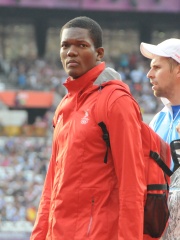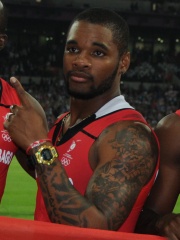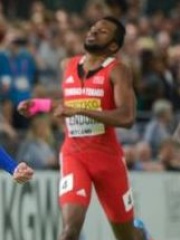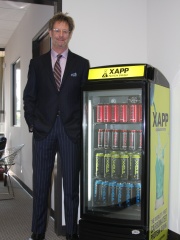
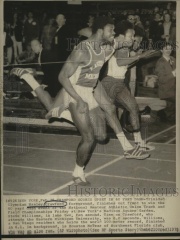

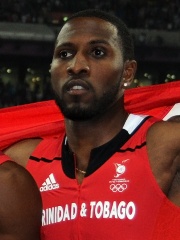
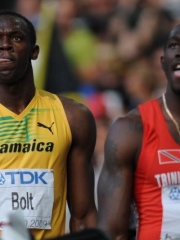
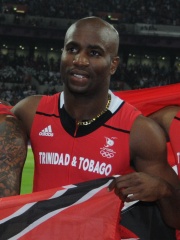
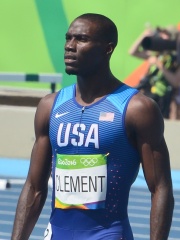

The Most Famous
ATHLETES from Trinidad and Tobago
This page contains a list of the greatest Trinidadian Athletes. The pantheon dataset contains 6,025 Athletes, 30 of which were born in Trinidad and Tobago. This makes Trinidad and Tobago the birth place of the 65th most number of Athletes behind Tunisia, and Armenia.
Top 10
The following people are considered by Pantheon to be the top 10 most legendary Trinidadian Athletes of all time. This list of famous Trinidadian Athletes is sorted by HPI (Historical Popularity Index), a metric that aggregates information on a biography's online popularity. Visit the rankings page to view the entire list of Trinidadian Athletes.

1. David Jenkins (b. 1952)
With an HPI of 56.33, David Jenkins is the most famous Trinidadian Athlete. His biography has been translated into 16 different languages on wikipedia.
David Andrew Jenkins (born 25 May 1952) is a former World ranked no.1 track and field 400 metres runner and statistically is the highest ranking Scottish sprinter in history. He was part of the British relay team which won a silver medal at the 1972 Munich Summer Olympics. In 1988, he received a 7-year prison sentence for drug smuggling, but was able to serve a reduced sentence by becoming an informant.

2. Hasely Crawford (b. 1950)
With an HPI of 53.72, Hasely Crawford is the 2nd most famous Trinidadian Athlete. His biography has been translated into 26 different languages.
Hasely Joachim Crawford TC, OLY (born 16 August 1950) is a former track and field athlete from Trinidad and Tobago. In 1976, he became his country's first Olympic champion. Hasely Crawford Stadium, in Port of Spain, was renamed in his honour in 2001.

3. McDonald Bailey (1920 - 2013)
With an HPI of 50.42, McDonald Bailey is the 3rd most famous Trinidadian Athlete. His biography has been translated into 15 different languages.
Emmanuel McDonald Bailey (8 December 1920 – 4 December 2013) was a British and Trinidadian athlete, who was born in Williamsville, Trinidad and Tobago and competed at two Olympic Games.

4. Richard Thompson (b. 1985)
With an HPI of 48.62, Richard Thompson is the 4th most famous Trinidadian Athlete. His biography has been translated into 27 different languages.
Richard "Torpedo" Thompson (born 7 June 1985) is a Trinidadian sprinter who specializes in the 100 metres. His personal best of 9.82 seconds, set in June 2014, was one of the top ten fastest of all time, and a national record. In the 200 meters, he has the fourth fastest time by a Trinidad and Tobago athlete. Thompson studied at Louisiana State University (LSU) and broke the National Collegiate Athletic Association (NCAA) indoor 60 metres record in 2008, his final season of collegiate athletics. At the 2008 Beijing Olympics, Thompson was the silver medalist in the 100 meters, running a then personal best of 9.89 seconds, and the gold medalist in the 4 × 100 meters relay along with Emmanuel Callender, Keston Bledman and Marc Burns. He also won the silver medal in the 4x100 meters at the 2012 Olympics with the same team he competed in the 2008 Olympics with. Also in the 2012 Olympics, he finished 6th following the disqualification of Tyson Gay in the final of the 100 meters. Thompson is a five time Trinidad and Tobago national champion. His current personal best of 9.82 was set at the 2014 Trinidad and Tobago national championships. In 2017, fellow sprinter and 2008 Olympic Games men's relay gold medalist Nesta Carter was sanctioned by the International Olympic Committee for doping at the 2008 event, retroactively awarding the Trinidad and Tobago team which included Thompson Olympic Gold.
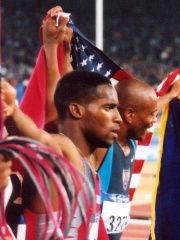
5. Ato Boldon (b. 1973)
With an HPI of 47.92, Ato Boldon is the 5th most famous Trinidadian Athlete. His biography has been translated into 33 different languages.
Ato Jabari Boldon (born 30 December 1973) is a Trinidadian former track and field athlete, politician, and four-time Olympic medal winner. He holds the Trinidad and Tobago national record in the 50, 60 and 200 metres events with times of 5.64, 6.49 and 19.77 seconds respectively, and also the Commonwealth Games record in the 100 m. He also held the 100 m national record at 9.86 s, having run it four times until Richard Thompson ran 9.85 s on 13 August 2011. After retiring from his track career, Boldon was an Opposition Senator in the Trinidad and Tobago Parliament, representing the United National Congress from 2006 to 2007. Boldon works as an NBC Sports television broadcast analyst for track and field.

6. Marc Burns (b. 1983)
With an HPI of 45.18, Marc Burns is the 6th most famous Trinidadian Athlete. His biography has been translated into 22 different languages.
Marc Burns (born 7 January 1983) is an athlete from Trinidad and Tobago specializing in the 100 metres and the 4 x 100 metres relay. Participating in the 2004 Summer Olympics, he was disqualified from his 100 metres heat due to a false start, thus failing to make it through to the second round. Marc Burns placed second in the men's 100 metres dash at the Bislett Games IAAF Golden League meet in Oslo in July 2005, in preparation for the 2005 World Championships in Athletics. At the 2005 World Championships he won (together with Kevon Pierre, Jacey Harper and Darrel Brown) a silver medal. Later that year he won the World Athletics Final. At the 2006 Commonwealth Games he won a bronze medal over 100 metres. He was a finalist in the 100 m final at the 2007 World Championships in Osaka. At the London Grand Prix he ran a season's best time of 9.97 seconds coming second behind former world record holder Asafa Powell. In the 2008 Summer Olympics he competed at the 100 metres sprint and placed 2nd in his heat after Samuel Francis in a time of 10.46 seconds. He qualified for the second round in which he improved his time to 10.05 seconds, winning his race with opponents as Kim Collins and Tyrone Edgar. In the semi-finals he finished 3rd (9.97 seconds) in his heat behind Usain Bolt and Walter Dix and qualified for the final. There he finished his race in 7th place in a time of 10.01 seconds. Together with Keston Bledman, Aaron Armstrong and Richard Thompson he also competed at the 4 × 100 metres relay. In their qualification heat they placed first in front of Japan, the Netherlands and Brazil. Their time of 38.26 was the fastest of all sixteen teams participating in the first round and they qualified for the final. Armstrong was replaced by Emmanuel Callender for the final race and they sprinted to a time of 38.06 seconds, the second time after the Jamaican team, winning the silver medal. In 2022, Burns and his teammates received the gold medal due to Jamaica's Nesta Carter testing positive for the prohibited substance methylhexaneamine. At the 2012 Summer Olympics, he was part of the Trinidad and Tobago team that won the silver medal in the men's 4 × 100 m relay. He was also part of the team that won the bronze medal at the 2014 Commonwealth Games. Burns was coached most of his professional career by Henry Rolle.

7. Emmanuel Callender (b. 1984)
With an HPI of 43.28, Emmanuel Callender is the 7th most famous Trinidadian Athlete. His biography has been translated into 19 different languages.
Emmanuel Earl Callender (sometimes Callander; born 10 May 1984 in Arouca, Trinidad and Tobago) is a track and field sprint athlete, who competes internationally for Trinidad and Tobago. Callender represented Trinidad and Tobago at the 2008 Summer Olympics in Beijing. He competed at the 4 × 100 m relay, together with Marc Burns, Aaron Armstrong, Keston Bledman and Richard Thompson. In their qualification heat (without Callender) they placed first in front of Japan, the Netherlands and Brazil. Their time of 38.26 was the fastest of all sixteen teams participating in the first round and they qualified for the final. Armstrong was replaced by Callender for the final race and they sprinted to a time of 38.06 seconds, the second fastest time after the Jamaican team, winning the silver medal. At the 2012 Summer Olympics, he raced in the first round and the final, and Trinidad and Tobago won the silver medal. Callender set new personal bests in the 100 and 200 meters at the Grande Prêmio Brasil Caixa meet in May 2009, recording times of 10.16 and 20.40 seconds respectively. Since then, he has improved his 100 m personal best, to 10.05 s.

8. Kerron Clement (b. 1985)
With an HPI of 41.97, Kerron Clement is the 8th most famous Trinidadian Athlete. His biography has been translated into 33 different languages.
Kerron Stephon Clement (born October 31, 1985) is a Trinidadian-born American track and field athlete who competes in the 400-meter hurdles and 400-meter sprint. He held the indoor world record in the 400-meter sprint, having broken Michael Johnson's mark in 2005. Clement won the hurdles at the 2016 Summer Olympics in Rio de Janeiro and the 2007 and 2009 World Championships. He also took silver behind Angelo Taylor at the 2008 Beijing Olympics. He is a frequent member of the American 4 × 400-meter relay and is a two-time world champion and Olympic gold medalist in the event. As a junior athlete, he set a championship record at the 2004 World Junior Championships and as a University of Florida Gator won back-to-back NCAA titles in 2004/2005. He quickly progressed on the senior circuit, taking the hurdles title at the USA Outdoor Track and Field Championships in both 2005 and 2006. He was fourth in his first global appearance at the 2005 World Championships and won his first global gold at the 2006 IAAF World Cup.

9. Jillian Richardson (b. 1965)
With an HPI of 41.75, Jillian Richardson is the 9th most famous Trinidadian Athlete. Her biography has been translated into 17 different languages.
Jillian Cheryl Richardson-Briscoe (born March 10, 1965, in San Fernando, Trinidad and Tobago) is a Canadian athlete who competed mainly in the 400 metres. She is a three-time Olympian. In 1988, she equalled Marita Payne's Canadian 400 metres record of 49.91 secs. The record (as of 2022) still stands. She was inducted into the Athletics Canada Hall of Fame in 2017. Richardson won a gold medal at the 1982 Commonwealth Games as a member of the 4 x 400 meter relay team. She repeated that feat at the 1986 Commonwealth Games, as well as winning a silver in the 400 meters. She was a member of the 4 x 400 metre relay that took a silver medal in the 1983 Pan American Games. She won a silver in the 400 meters at the 1987 Pan American Games, and as part of the Canadian 4 x 400 meter relay team. She took a gold medal in the 400 metres and a silver medal in the 4 x 400 metre relay at the 1989 Francophone Games. She competed for Canada at three Olympic Games. At the 1984 Olympics in Los Angeles, she won the silver medal in the 4 x 400 metres relay with her teammates Charmaine Crooks, Molly Killingbeck and Marita Payne. At the 1988 Olympics in Seoul, she was eliminated in the 400 metres semi-finals, running 49.91. It was the first time someone had broken 50 seconds and failed to reach the final. Canada failed to finish the 4 × 400 m relay final due to an injury to Molly Killingbeck. At the 1992 Olympics in Barcelona, she finished fifth in the 400 m final, in 49.93 and fourth in the 4 × 400 m relay final.

10. Glenroy Gilbert (b. 1968)
With an HPI of 40.96, Glenroy Gilbert is the 10th most famous Trinidadian Athlete. His biography has been translated into 16 different languages.
Glenroy John Gilbert (born August 31, 1967) is a Canadian former track and field athlete, winner of the gold medal in 4 × 100 metres relay at the 1996 Summer Olympics, and head coach of Athletics Canada.
People
Pantheon has 30 people classified as Trinidadian athletes born between 1920 and 1999. Of these 30, 28 (93.33%) of them are still alive today. The most famous living Trinidadian athletes include David Jenkins, Hasely Crawford, and Richard Thompson. The most famous deceased Trinidadian athletes include McDonald Bailey, and Deon Lendore. As of April 2024, 2 new Trinidadian athletes have been added to Pantheon including Jillian Richardson, and Ade Alleyne-Forte.
Living Trinidadian Athletes
Go to all RankingsDavid Jenkins
1952 - Present
HPI: 56.33
Hasely Crawford
1950 - Present
HPI: 53.72
Richard Thompson
1985 - Present
HPI: 48.62
Ato Boldon
1973 - Present
HPI: 47.92
Marc Burns
1983 - Present
HPI: 45.18
Emmanuel Callender
1984 - Present
HPI: 43.28
Kerron Clement
1985 - Present
HPI: 41.97
Jillian Richardson
1965 - Present
HPI: 41.75
Glenroy Gilbert
1968 - Present
HPI: 40.96
Keshorn Walcott
1993 - Present
HPI: 37.79
Keston Bledman
1988 - Present
HPI: 37.19
Jarrin Solomon
1986 - Present
HPI: 36.23

